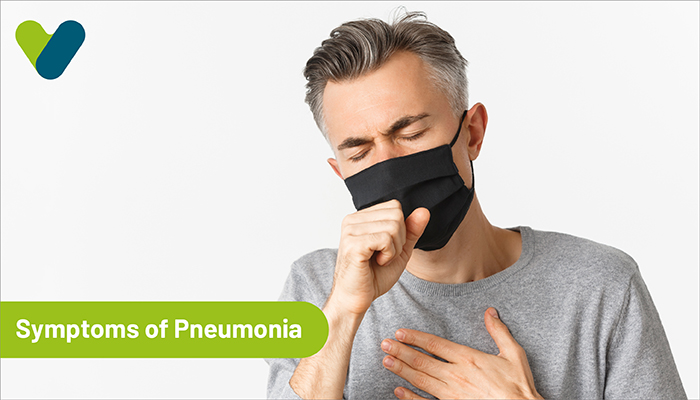Pneumonia is a lung infection that causes the swelling of the lung tissue. Bacteria, virus or fungi are naturally present in the upper respiratory tract. The body’s immune receptors usually prevent the germs from severely infecting the lungs. Certain conditions, however, may cause the germs to overpower the body’s defence mechanisms and cause an infection.
In patients suffering from pneumonia, the infection spreads in the air sacs of the lungs where exchange of oxygen and carbon dioxide takes place. The lungs get filled with fluid or pus, which can make breathing difficult. Other prominent pneumonia symptoms include persistent cough with phlegm, high fever and chills.
Pneumonia – An Overview
Pneumonia affects the lungs, considered the most important organs of the respiratory system. When you inhale, the lungs expand, and the air sacs supply oxygen to the blood. When you exhale, the lungs contract, and carbon dioxide is released. This normal lung function can get hindered when the airways and air sacs get infected by pathogens.
In normal conditions, you would typically inhale germs that stay in the upper sections of the respiratory system. Mucus entrapment, ciliary function in the walls of the airways, epithelial barriers and antibody production are ways the body fights foreign substances. However, these pathogens can multiply excessively and disrupt the defence mechanism. When that happens, the body has to generate more antibodies to fight the germs. Antibodies are localised to infected areas like the airways and air sacs. The lung tissues swell and cause various symptoms.
Pneumonia – Symptoms
Depending on the pathogen, pneumonia can be classified into three types: bacterial, viral and fungal. The commonly apparent, early signs of pneumonia are as follows:
- Cough with Phlegm: When foreign particles irritate the breathing passages, the body expels a gush of air in the form of cough. Irritants that come in contact with the airways are also expelled by the hair-like structures called cilia. The cilia produce mucus to assist the foreign particles out of the body. In case of pneumonia, the mucus gets mixed with virus, bacteria and other debris and becomes thick. This type of mucus is called phlegm. During pneumonia, the body clears the airways with cough and expels phlegm.
- Fever: When you contract an infection, the white blood cells produce antibodies. These antibodies localise to the infected area to fight the infection-causing agents. This situation elevates the body’s temperature and causes fever. If you have pneumonia, a fever is an indication that your body is effectively controlling the infection. However, your doctor may prescribe fever-reducing drugs like aspirin and ibuprofen to manage the early signs of pneumonia fever.
- Chills: Infectious diseases can also make you feel cold. You can get chills at the start of an infection. The rapid contraction and relaxation of muscles causes chills. It is the body’s way of keeping itself warm when you get cold. Chills are important warning sign of pneumonia and there are rather common among children. If your body suddenly gets cold, it could be an early sign of pneumonia.
- Shortness of Breath: During pneumonia, the airways and air sacs get blocked, making breathing difficult. The lungs need to work extra hard to inhale and exhale. This leads to dyspnoea, commonly known as shortness of breath. Simple techniques like pursed-lip breathing, diaphragmatic breathing, sitting forward, etc., can help you alleviate the breath shortness symptoms.
- Tachypnoea: Blocked airways due to pneumonia can cause oxygen shortage. You tend to take rapid and shallow breaths to inhale more oxygen. This condition is called tachypnoea. Tachypnoea is a concerning symptom of pneumonia in infants. They may need treatment to either increase the oxygen levels or open the airways.
- Nausea and Vomiting: Nausea is associated with revulsion to food and is generally causes vomiting. During pneumonia, the nerve endings in the stomach (duodenum) get irritated. This, in turn, simulates the nausea and vomit-causing regions of the brain. You can treat nausea with proper rest, by eating light and bland foods, consuming refreshing drinks, etc.
- Sharp Chest Pain: Chest pain stems from inflamed lung tissues. The chest protects the lungs and other vital organs. Painful stimuli from the lungs can put pressure on the thoracic (chest) walls. This causes discomfort that ranges from mild to sharp chest pain. Sharp chest pain can be a sign of lung infection.
- Fatigue: Fatigue is characterized by difficulty initiating and sustaining any type of activity. Lack of energy along with a strong desire to rest is often a side effect of fatigue. Dehydration, fever, chills, etc., during pneumonia make your body lose energy. A proper sleep schedule accompanied with a healthy diet can help reduce fatigue.
- Mental Confusion: Mental confusion or delirium is one of the common pneumonia signs and symptoms, especially in older adults. The clinical hallmarks of delirium include changes in baseline cognition and decreased attention. Infections like pneumonia call for large antibody production. These antibodies can interfere with the blood-brain barrier. Delirium is usually reversible.
- Appetite Loss: Nausea and vomiting due to pneumonia can prevent you from ingesting essential foods and drinks. The discomforting feeling that eating would be followed by vomiting makes you lose your appetite. Bland but nutrient rich foods are necessary for boosting immunity to fight the pneumonia germs. Once you recover from pneumonia, your appetite will return.
- Bluish Lips And Fingernails: Since pneumonia causes airway blockage, maximum oxygenated blood goes to vital organs like the brain or heart. Your fingernails and lips that are the farthest from the heart and lungs receive less blood and hence, appear blue. The blood vessels underneath the skin also receive less oxygenated blood, thereby causing paleness.
How To Manage Pneumonia Symptoms
Home remedies and over-the-counter medication can help relieve the symptoms of pneumonia in adults as well as children.
- Medication: You can reduce fever and pain symptoms with over-the-counter drugs like aspirin or ibuprofen. You must, however, check with your doctor before taking any such medication. You can also relieve cough using cough suppressants. While coughing is necessary for clearing the airways, excess cough can cause headaches and chest pain.
- Breathing Exercises: Pneumonia alters the lung function which you can restore with simple breathing exercises. These exercises also help restore the diaphragm functions necessary for inhalation and exhalation. With deep breathing, your nervous system can relax while you recover from lung infections rapidly.
- Using A Humidifier: Humidifiers can help alleviate symptoms of pneumonia in infants and children. Humidifiers add moisture in the air to prevent the airways from drying out. They also helps loosen mucus and ease congestion. Besides using humidifiers, giving your pneumonia-infected children a steamy bath helps provide tentative relief.
Conclusion
Recognizing the symptoms of pneumonia early can be a crucial step you take towards early treatment. It can make a signifcant different in how quickly you recover and how effectively the infection is treated. Some of the most common early warning signs of pneumonia include cough with phelgm, fever, chills, shortness of breath, severe fatigue, and more. Each symptom is a sign that the lung is struggling to function properly. When you understand the symptoms of pneumonia, you seek timely medical care. Always make sure to follow the prescribed treatment precisely. The adequate treatment plan, combined with plenty of rest, hydration, and breathing exercises, can ensure faster recovery and prevent complications.


